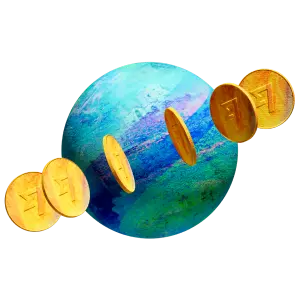หยวนจีน (RMB) (CNY)
หยวนจีนเป็นสกุลเงินทางการของจีนแผ่นดินใหญ่ ซึ่งในทางเทคนิคแล้ว เงินหยวนเป็นหน่วยฐานของสกุลเงินเหรินหมินปี้ (RMB) แต่บางครั้งก็เรียกแทนกันกับเงินเหรินหมินปี้ได้
ชื่อสกุลเงิน
หยวนจีน (RMB)
สัญลักษณ์สกุลเงิน
¥
อัตราแลกเปลี่ยน CNY
| USD | HKD | CAD | EUR | GBP | AUD | INR | SGD | |
|---|---|---|---|---|---|---|---|---|
| จาก CNY | 0.13701 | 1.06447 | 0.19697 | 0.13170 | 0.10930 | 0.21953 | 11.66280 | 0.18594 |
| เป็น CNY | 7.29875 | 0.93944 | 5.07686 | 7.59325 | 9.14935 | 4.55515 | 0.08574 | 5.37800 |
ระวังอัตราแลกเปลี่ยนราคาแพงธนาคารและผู้ให้บริการแบบดั้งเดิมมักจะมีค่าใช้จ่ายเพิ่มเติม ซึ่งพวกเขามักจะนำมาคิดเงินคุณด้วยการเพิ่มอัตราแลกเปลี่ยน เทคโนโลยีอันชาญฉลาดของเราจะช่วยให้เรามีประสิทธิภาพมากขึ้น ซึ่งยังช่วยให้คุณได้รับอัตราแลกเปลี่ยนที่ยอดเยี่ยมในทุกครั้งอีกด้วย
| ชื่อ | หยวนจีน (CNY) |
|---|---|
| สัญลักษณ์ | ¥ |
| หน่วยย่อย | เจียว (คิดเป็น 1/10 ของหนึ่งหยวน) |
| สัญลักษณ์หน่วยย่อย | 角 |
| ธนบัตรที่นิยมใช้ | ¥1, ¥5, ¥10, ¥20, ¥100 |
| เหรียญที่นิยมใช้ | ¥1, ¥5, 10, 50 Jiao |
| ธนาคารกลาง | ธนาคารแห่งประชาชนจีน People's Bank of China (PBOC) |
| ผู้ใช้ | จีน |
ตารางข้อเท็จจริงเกี่ยวกับเงินสกุลหยวนจีน (CNY)
สกุลเงินอย่างเป็นทางการของจีนคือหยวนจีน (Chinese Yuan) หรือที่เรียกกันว่าเหรินหมินปี้ (renminbi - RMB) โดยอัตราแลกเปลี่ยนเงิน CNY เป็น USD เป็นอัตราแลกเปลี่ยนที่ใช้กันอย่างแพร่หลายมากที่สุด รหัสสกุลเงินสำหรับหยวนเหรินหมินปี้ของจีนคือ CNY แสดงด้วยสัญลักษณ์ ¥

ต้นกำเนิดของสกุลเงินจีน
ย้อนหลังไปกว่า 3000 ปีสกุลเงินจีนมีรากฐานมาจากทั้งจีนโบราณและจักรวรรดิจีนในปี 1914 สาธารณรัฐจีนได้จัดตั้งเหรียญเงิน (Silver Dollar) เป็นสกุลเงินอย่างเป็นทางการ ซึ่งตามมาด้วยการนำเหรียญทองแดง เหรียญเฟิน และเหรียญนิกเกิลมาใช้ในช่วงทศวรรษที่ 1930 อย่างไรก็ตามเมื่อเงินมีมูลค่าเพิ่มสูงขึ้นทำให้มีการเปลี่ยนมาตรฐานเดิมที่ใช้โลหะไป ดังนั้นในปี 1935 จึงมีการเปิดตัวสกุลเงินใหม่ชื่อ ฝ่าปี้ (Fǎbì)

จุดเริ่มต้นของหยวนทองและเงินหยวนเหรินหมินปี้ของจีน
ในปี 1948 หยวนทองคำได้เข้ามาแทนที่ Fǎbì ซึ่งมีอัตราการแปลง 1 หยวนทองคำเท่ากับ 3 ล้านหยวน Fǎbì ในเวลาเดียวกันหยวนเหรินหมินปี้ (โดยทั่วไปเรียกว่าหยวน - RMB) ก็ถูกนำมาใช้เพื่อรักษาเสถียรภาพของภูมิภาคที่ควบคุมโดยคอมมิวนิสต์ของจีนแผ่นดินใหญ่ และต่อมาในปี 1955 ก็มีการประเมินผลอีกครั้ง ซึ่งส่งผลให้มีการนำหยวนเหรินหมินปี้ใหม่มาใช้ในอัตรา 1 หยวนใหม่เท่ากับ 10,000 หยวนเก่า

เงินหยวนเหรินหมินปี้ในการแลกเปลี่ยนเงินทั่วโลก
ในช่วงที่มีการควบคุมเศรษฐกิจ เงินสกุลหยวนเหรินหมินปี้ของจีนถูกตรึงไว้กับค่าแลกเปลี่ยนที่ไม่สมจริง ซึ่งนำไปสู่กฎระเบียบที่เข้มงวดเกี่ยวกับสกุลเงิน โดยในขณะที่เศรษฐกิจของจีนเริ่มเปิดขึ้นในปี 1978 สกุลหยวนเหรินหมินปี้ก็ถูกนำมาใช้ประโยชน์ในประเทศเป็นหลัก กระตุ้นให้ชาวต่างชาติหันมาใช้ใบรับรองการแลกเปลี่ยนซึ่งส่งผลให้เกิดตลาดมืดที่เฟื่องฟู
ตั้งแต่ปี 1997 ถึง 2005 ทางรัฐบาลจีนได้กำหนดอัตราแลกเปลี่ยนของหยวนเหรินหมินปี้เป็นดอลลาร์สหรัฐไว้ที่อัตราโดยประมาณ 8.3 CNY เท่ากับ 1 USD และในปี 2005 ก็มีการเปิดตัวกลไกอัตราแลกเปลี่ยนที่ยืดหยุ่นมากขึ้นโดยปรับสกุล RMB เป็น 8.1 Renminbi ต่อดอลลาร์สหรัฐ ทางจีนได้มีการริเริ่มโครงการนำร่องในปี 2009 โดยอนุญาตให้ธุรกิจบางอย่างในภูมิภาคเช่น กวางตุ้งและเซี่ยงไฮ้ดำเนินการค้ากับคู่ค้าในฮ่องกง มาเก๊า และบางประเทศ ซึ่งโครงการนี้ได้ขยายไปทั่วประเทศและต่างประเทศ นอกจากนี้จีนได้สร้างข้อตกลงการค้าสกุลเงินโดยตรงกับออสเตรเลีย ญี่ปุ่น ไทย รัสเซีย และเวียดนามโดยไม่จำเป็นต้องแลกเงินเป็นดอลลาร์สหรัฐ ซึ่งปัจจุบันมูลค่าของเหรินหมินปี้ดำเนินการภายใต้ระบบลอยตัวภายใต้การจัดการที่กำหนดโดยตะกร้าสกุลเงินต่างประเทศ